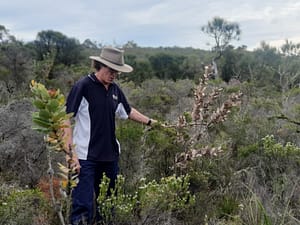Watching Jeremy Spencer walk through the bush is a bit like an episode of CSI – South Coast. The dieback interpreter from Great Southern Bio Logic can trace the chronology of plant deaths as Phytophthora dieback moves through the landscape like a slow-moving shockwave.
Jeremy was working near Ravensthorpe last month, marking out a small dieback infestation on Desmond Track and looking for new areas of disease in the nearby Mt Desmond Priority Protection Area.
The spot infestation on Desmond Track stretches for around 350m along the popular wildflower tourist route, home to a wealth of declared rare flora and threatened kwongkan heathland containing banksias and hakeas, both highly susceptible to dieback.
“During wildflower season, people pull over on Desmond Track and Elverton Rd, and park in the damp gutter, potentially picking up contaminated soil on their tyres and boots,” South Coast Natural Resource Management Inc. dieback officer Mia Hunt says.
“Dieback interpreters go out and do forensics in the bush and try to track down where the edge of the disease is. They take samples from plants which they believe have been recently killed by disease and send it to a lab for identification.
“As far as we know the disease is relatively contained, and that is probably because of the dry climate in Ravensthorpe. Upgrading drainage and the road surface to reduce the risk of vehicles spreading the disease on their car tyres is one of the options we are investigating. But it is still important for people to clean tyres and boots of any mud and dirt if travelling through this disease risk area.”
Shire of Ravensthorpe and Hopetoun and South Coast Natural Resource Management Inc. will use the survey findings to scope a range of actions to reduce the risk of the disease spreading further.
These activities are supported by funding from the State Natural Resource Management Program WA

